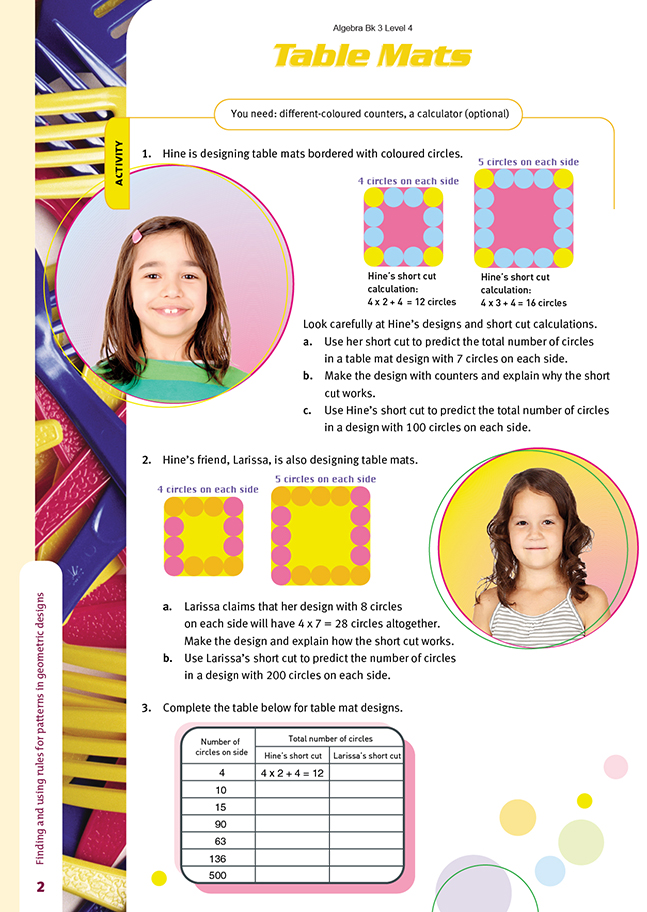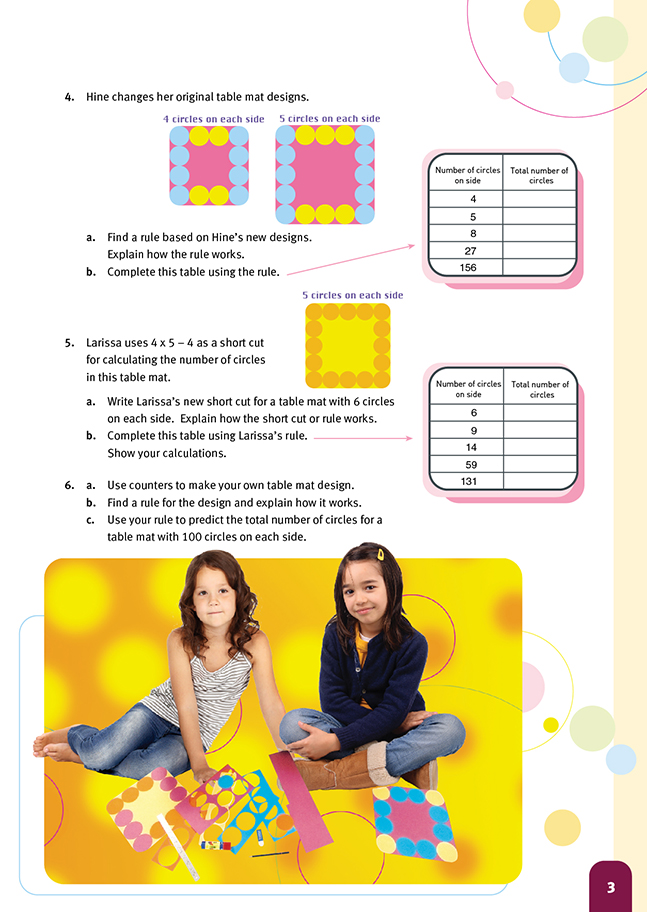This is a level 4 algebra strand activity from the Figure It Out series.
A PDF of the student activity is included.
Click on the image to enlarge it. Click again to close. Download PDF (402 KB)
use a table to find a rule for a geometric pattern
write the rule for a relationship as a linear equation
different-coloured counters
FIO, Level 4, Algebra, Book Three, Table Mats, pages 2-3
calculator (optional)
In this activity, students find short cuts and rules to work out the number of circles on the borders of different table mats. The designs referred to in the following notes are shown in the student book or in the Answers.
In question 1, the short cuts for the number of circles on the border of each table mat designed by Hine lead to a rule that can be applied generally. The rule is: any table mat has 4 (blue) sets of 2 fewer circles than the number of circles on a side, plus 4 corner circles (yellow). This rule can be expressed algebraically: a table mat with x circles on a side has 4 x (x – 2) + 4 circles or 4(x – 2) + 4 altogether.
In question 2, Larissa’s table mat designs lead to a different rule: any table mat has 4 sets of 1 fewer circles than the number of circles on a side. So a table mat with x circles on a side has 4 x (x – 1) or 4(x – 1) circles altogether.
In question 4, another rule for Hine’s new table mat design, in addition to the one given in the Answers, is: any table mat has 2 sets of the number of blue circles on a side, plus 2 sets of 2 circles fewer than the number of blue circles on a side. So any of Hine’s new table mat designs with x circles on a side has 2 x x + 2 x (x – 2) or 2x + 2(x – 2) circles altogether.
In question 5, the short cut for Larissa’s new table mat design with 5 circles on each side is given as 4 x 5 – 4. While there are 5 circles on each side, each corner circle is included twice in this count. So we subtract 4 corner circles to correct this double counting.
These short cuts lead to a rule that can be expressed in words and also algebraically: a table mat with x circles on each side has 4 x x – 4 circles or 4x – 4 altogether.
While the rules arising from the short cuts above are different, they all produce the same results for particular table mats.
.gif)
Most students will not be ready to use these rules involving symbolic algebra. It will be enough that they see how the different short cuts arise for particular table mats, that is, that they can relate the short cuts to the different table mat designs and can use them to predict the number of circles for table mats of any size.
More able students might like to attempt to show the algebraic equivalence of the different rules.
The first three rules all reduce to the fourth rule, 4x – 4. The equivalences are shown below:
Rule 1: 4(x – 2) + 4 = 4x – 8 + 4
= 4x – 4
Rule 2: 4(x – 1) = 4x – 4
Rule 3: 2x + 2(x – 2) = 2x + 2x – 4
= 4x – 4
Answers to Activity
1. a. 4 x 5 + 4 = 24
b.
.gif)
There are 5 blue circles on each side, so there are 4 sets of 5 blue circles and a yellow circle in each corner.
c. A table mat with 100 circles on each side will have 4 x 98 blue circles and 4 yellow corner circles. So it will have a total of 4 x 98 + 4 = 396 circles.
2. a.
.gif)
There are 2 sets of 7 orange circles and 2 sets of 7 pink circles. So there are 4 sets of 7 circles or 4 x 7 = 28 circles.
b. 4 x 199 = 796 circles
3a.
.gif)
4. a. Answers may vary. A rule is: 2 times the blue set of circles plus 2 times the yellow set of circles. Using this rule, the short cut for the design with 4 circles on each side is 2 x 4 + 2 x 2 = 12 circles. For the design with 5 circles on each side, the
short cut is 2 x 5 + 2 x 3 = 16 circles.
b.
.gif)
5. a. 4 x 6 – 4. In each short cut, the number of circles on any side is first multiplied by 4 (the number of sides). But the 4 corner circles will then have been included twice, so 4 circles must be subtracted.
b.
.gif)
6. a. Answers will vary. One design is shown below.
.gif)
b. A rule for the design above is: 2 times the number of colour a counters in one side plus 2 times the number of colour b counters in one side, plus 2. For the design above with 5 circles on each side, the short cut is (2 x 4) + (2 x 3) + 2 = 16. For the
design with 7 circles on each side, the short cut is (2 x 6) + (2 x 5) + 2 = 24.
c. For the design above:
(2 x 99) + (2 x 98) + 2 = 396 circles

